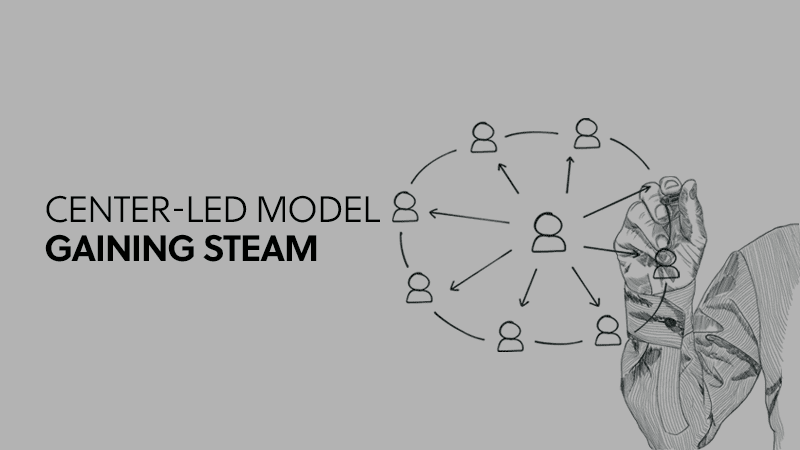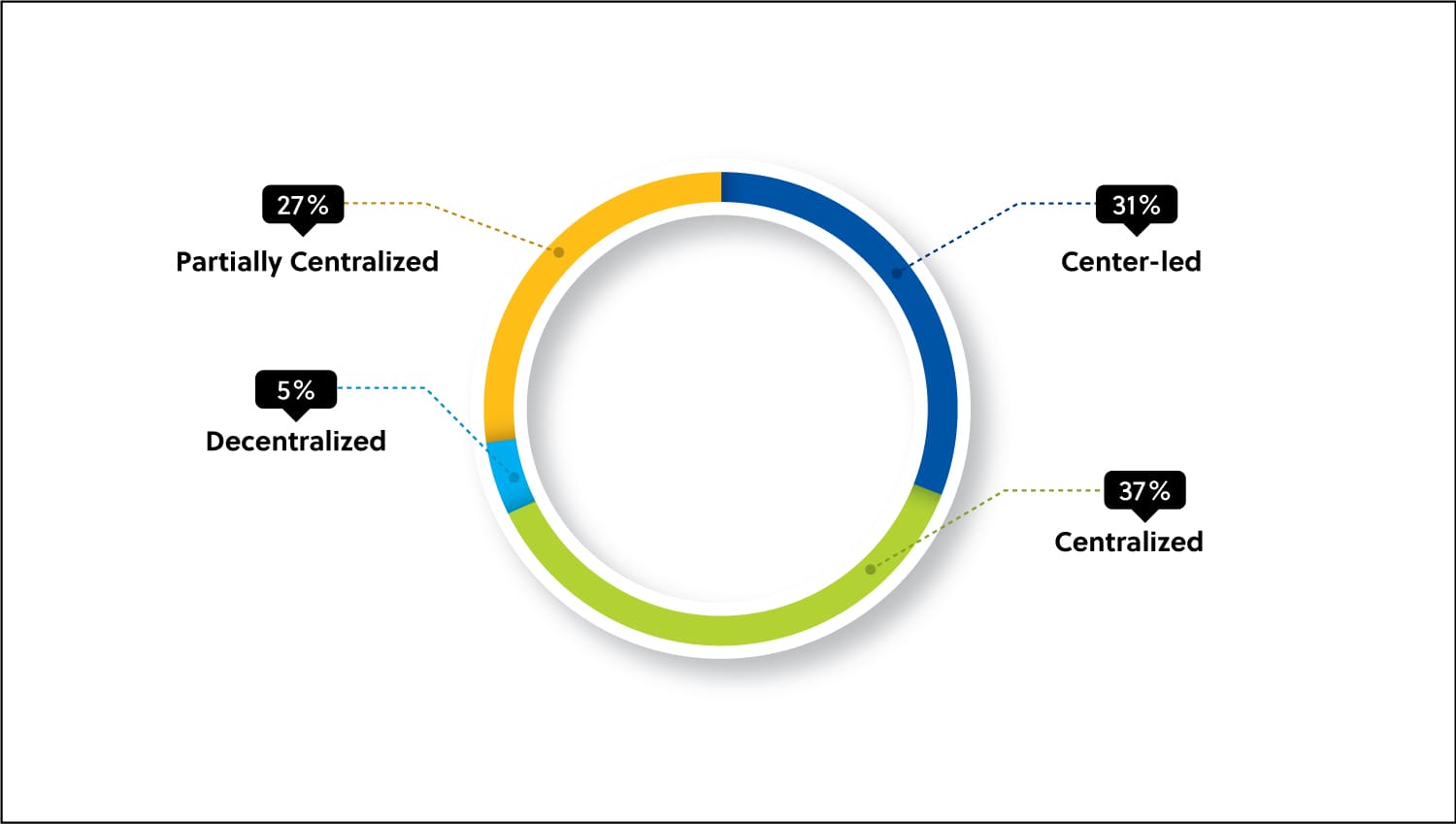
Beroe LiVE Poll: Center-led model gaining traction but maturity matters

In collaboration with Ipsita Suman, Principal Analyst

Procurement Organizations have been structured differently across companies. And there has been an age-old struggle between centralized and decentralized procurement structures.
We ran a poll among users of Beroe LiVE, a community of thousands of Procurement decision makers, to find out what is the effective procurement structure. The results showed that Centralized came out on top followed by Center-led structure. Center-led model incorporates features from both Centralized and Decentralized models.
A full-fledged Decentralized structure received only 5 percent of the votes.
Procurement Organizations started out as decentralized entities in the past. However, in order to exchange best practices and introduce standardization, centralization was required.
However, as consulting firm KPMG said in one of its report, the differences between the operating models are often more nuanced than one might expect. KPMG found, for instance, that even decentralized organizations still have many staff working in a central location.

Below table sets out the broad differences between Centralized and Decentralized procurement organization structure.
|
Parameters |
Centralized |
Decentralized |
|
Cost |
Bulk orders enable cost effectiveness. |
Regional cells lose out on the financial benefit of bulk orders. |
|
Standardization |
More standardization is possible. Helps in achieving efficiency of operations and standard quality of products across all the assets or regions. |
Each region can have a customized specification for each of its spend category and function. |
|
Lead Time |
Lead time for standardized equipment can be greatly reduced and suppliers can maintain future inventory level. |
In case of unexpected and emergency conditions, prior association with local vendor can help to reduce lead time. |
|
Value of Spend Category |
Usually done for heavy spend categories. |
Low spend categories are preferred to be procured locally. |
|
Line of Sight |
Cross-asset line of sight ensures a wider portfolio control. |
Limited or no cross-asset line of sight. |
|
Strategic Alliance |
Integrated contract is an enabler for setting up a strategic alliance with the suppliers. |
It is usually on ad hoc basis giving minimum benefits of alliances. |
|
Synergy |
It effectively captures system-wide learning because of wider exposure at the center. |
Company-wide technical learning is lost because of decentralization of core skills. |
|
Scope |
The outlook is toward achieving long-term sustainability at an organization level. |
Outlook is asset driven. |
Key trends in Procurement Organization Structure for Best-In-Class organizations
1. Center-led structure
- While moving towards centralization, organizations realized that it is best to keep scope for local sourcing, which would not be possible due to centralized policies.
- Best in Class companies are currently moving towards Center-led organization structure -- having standardized control over the procurement organization with adequate power given to stakeholders for local procurement.
- However, mature organizations that are doing very well in a decentralized setup are not necessarily moving towards a center-led structure.
2. Center of Excellence and Shared Service Center/ Global Business Services
- Establishing Shared Service Center for transactional activities brings about standard operating principles and eliminates back office work in the Procurement teams. Procurement Outsourcing is also common practice for transactional procurement.
- Center of excellence (CoE) team acts as a centralized best practice resource for Innovation in Procurement. CoE teams are established in all areas of the Procurement cycle. Popular areas for CoE are Research and Development, Supplier Relation Management and Innovation Center.
- Organizations also take the help of third-party organizations in order to stay informed about the latest trends in the market. The third party organization may support the Shared service team/ Center of Excellence team/ core Procurement team
3. Centralized Procurement Data
- Strong IT interface between the sourcing and transactional procurement teams have to be built for successful shared service center implementation.
- Also, master data has to be standardized and updated on a periodic basis.
- A centralized procurement data makes analytics possible and gives a clear picture of the performance.
- Knowledge management portal helps in best practice sharing among category teams across regions and verticals.
Below table lists out case studies of several Procurement Organizations who went in for organization redesign.
|
Organization |
Org Structure |
Challenges Faced |
Key Benefits after Org redesign |
|
• Industry – FBT |
Center-led |
Initial communication challenges faced while transitioning from decentralised to center-led structure |
Shared Service Center and Center of Excellence (CoE) act as support centers for Procurement |
|
• Industry – Pharma |
Decentralized with Central Finance team |
Transactional activities done by the Category team |
The Finance, Audit, Controls team supported the entire Procurement Organization with respect to Audit and Compliance. |
|
• Industry – Pharma *Medium maturity organization |
Decentralized |
Lack of Best Practice sharing among regions at a Category level |
Effective local sourcing and supplier management |
|
• Industry – Pharma |
Centralized |
Required extensive knowledge of local markets while facing increased risk of maverick buys |
Dedicated team for global planning maintains standardization for the procurement organization |
As one can see from above the table, each company adopted a different Procurement structure based on their business need and challenges -- and there is no silver bullet when it comes to cost savings.
Moreover, the level of maturity -- of both Procurement as well as Suppliers -- plays a crucial role in choosing a particular organization structure.
Procurement Maturity Characteristics
In general, high maturity Procurement Organizations are prime candidates for Center-led structure. Following are the typical characteristics of a high maturity organization:
- Sourcing activities are based on the category approach
- A centralized team is in charge of Risk control and Compliance
- A Center of Excellence (CoE) supporting procurement teams across the globe
- Data compatibility between Supplier and Corporate systems; usage of ERP and Business Intelligence tools
- Creation of a central repository for Knowledge Management
- Established dotted line reporting with well-defined responsibilities and accountabilities
Conclusion
Despite the overhaul in the operating model, the journey from Decentralized to Centralized structure does not always cleanse out the past habits.
As per KPMG’s observation, as companies move from Decentralized to more Centralized structures, they do not lose the benefits of being decentralized (such as stakeholder proximity and responsiveness). Rather, these qualities are retained as firms centralize procurement activities.
At the end of the day, Procurement operating models should be viewed from the prism of efficiency rather than cost savings alone.
Related Insights:
View All
Get more stories like this
Subscirbe for more news,updates and insights from Beroe






